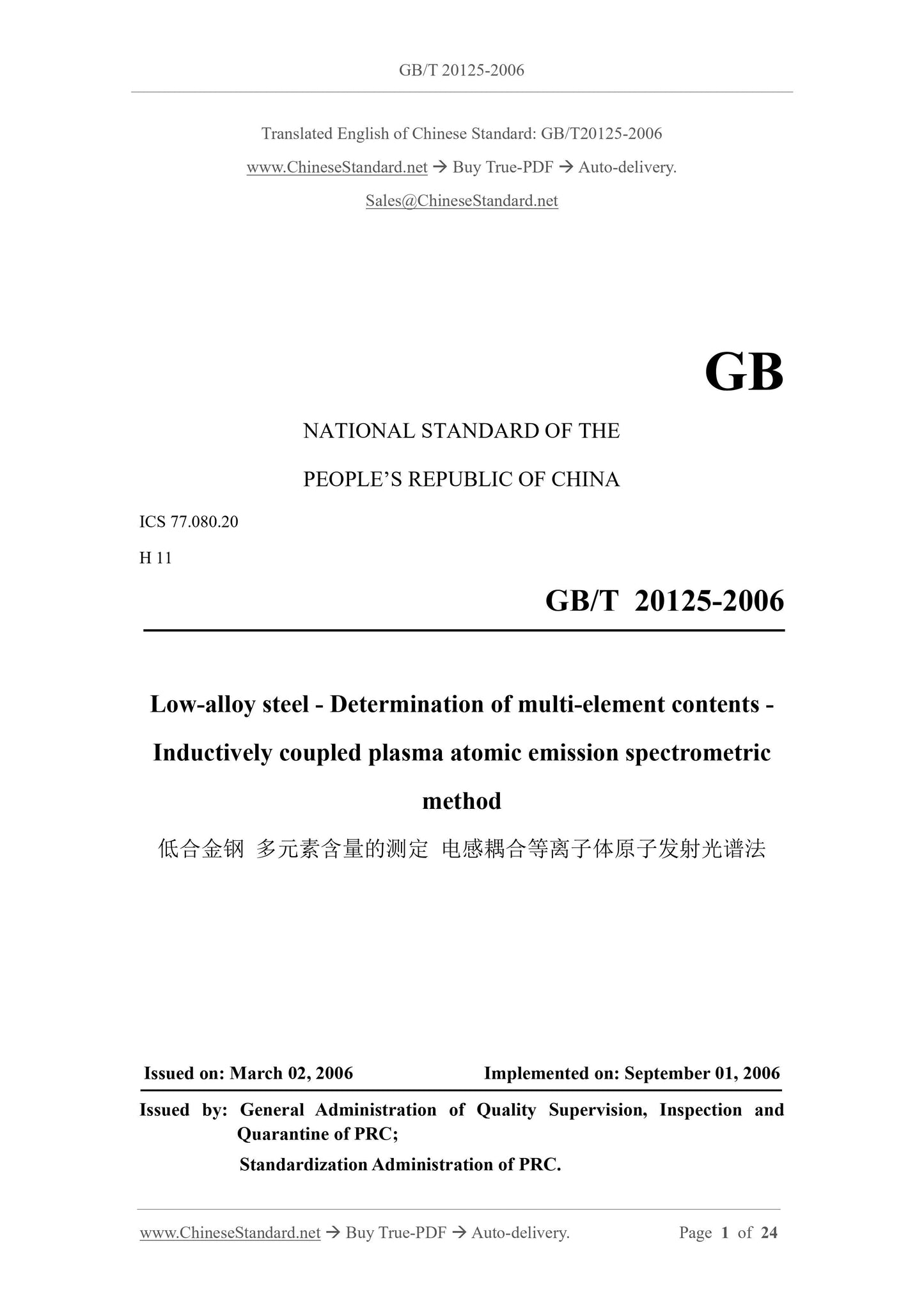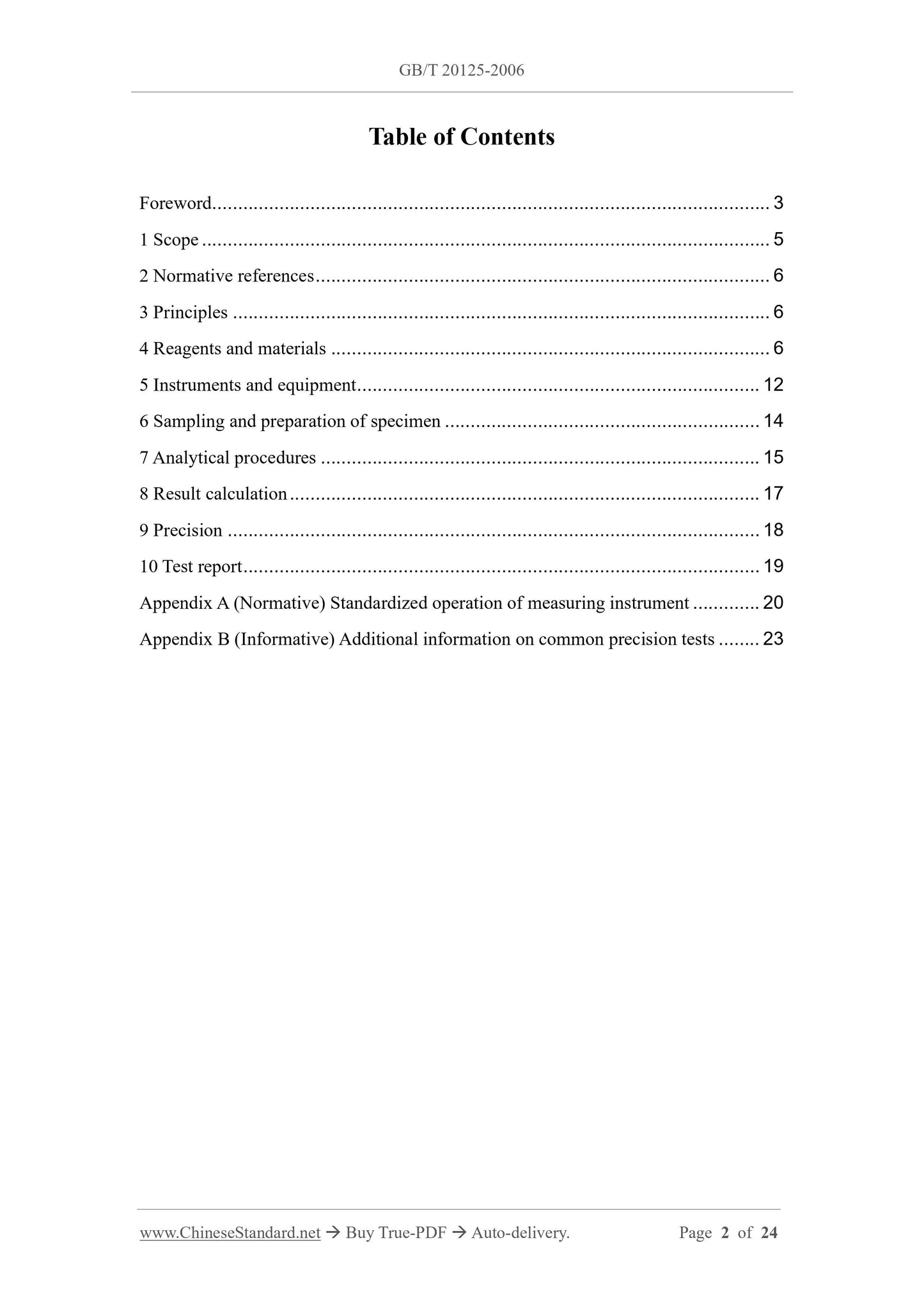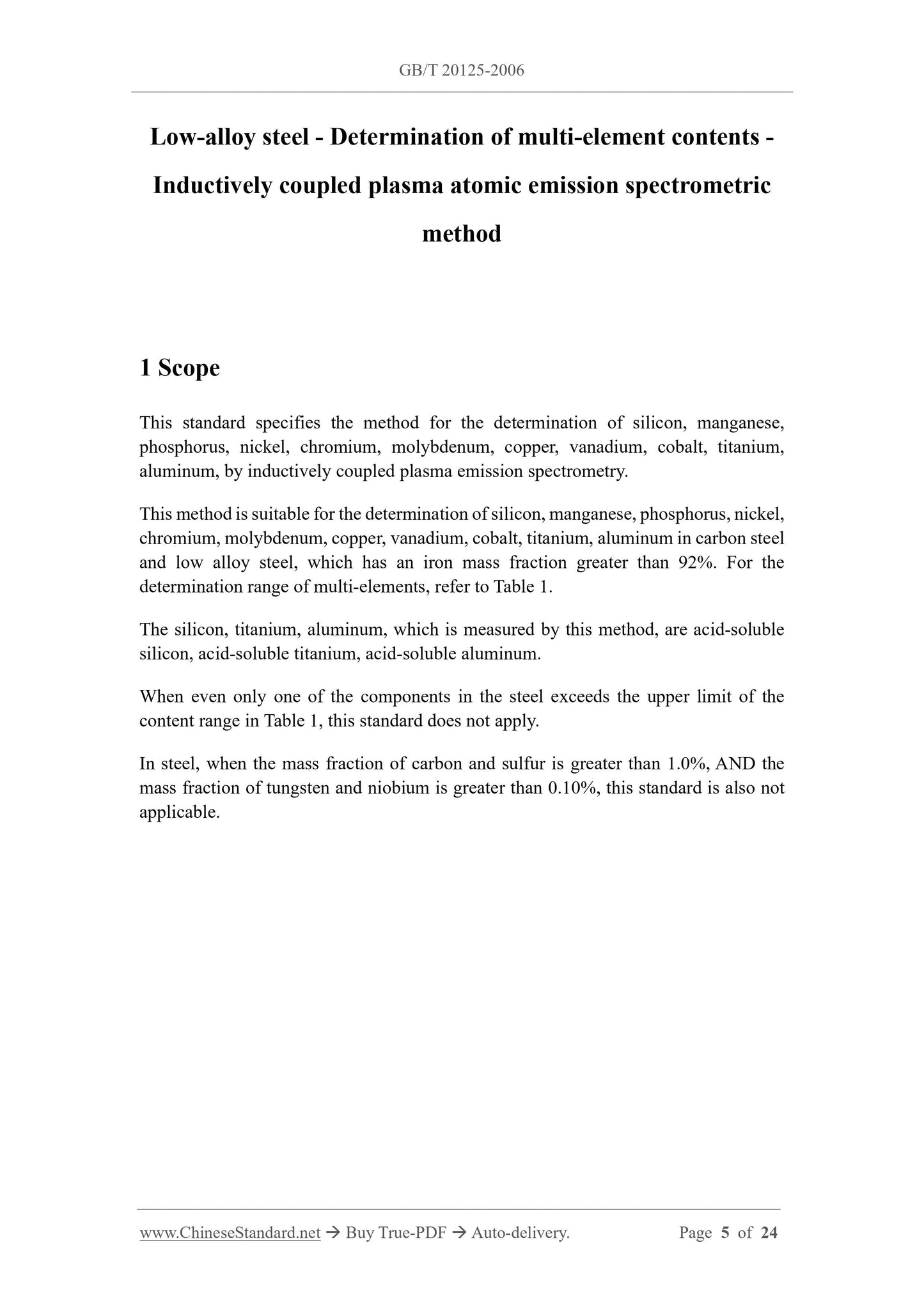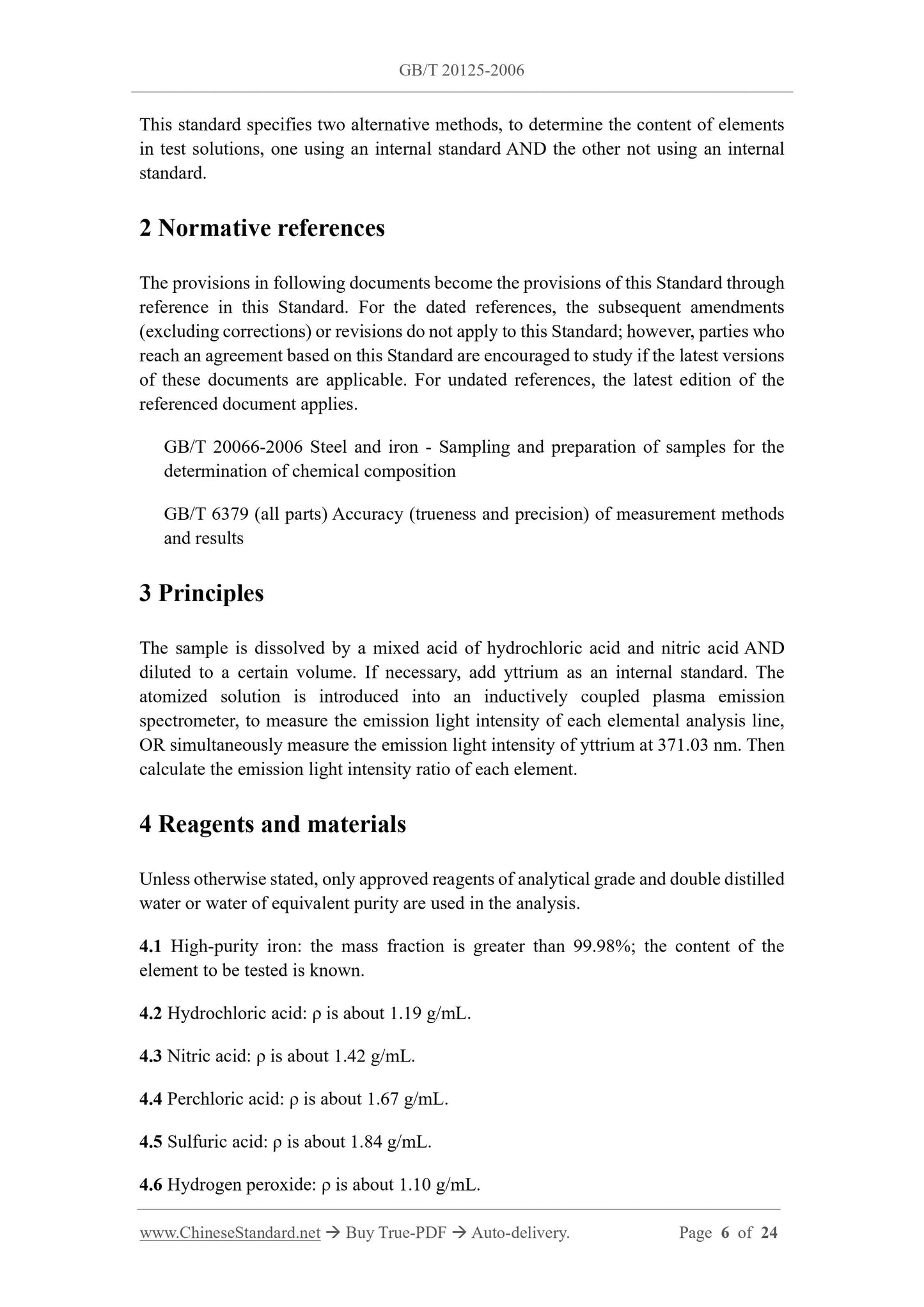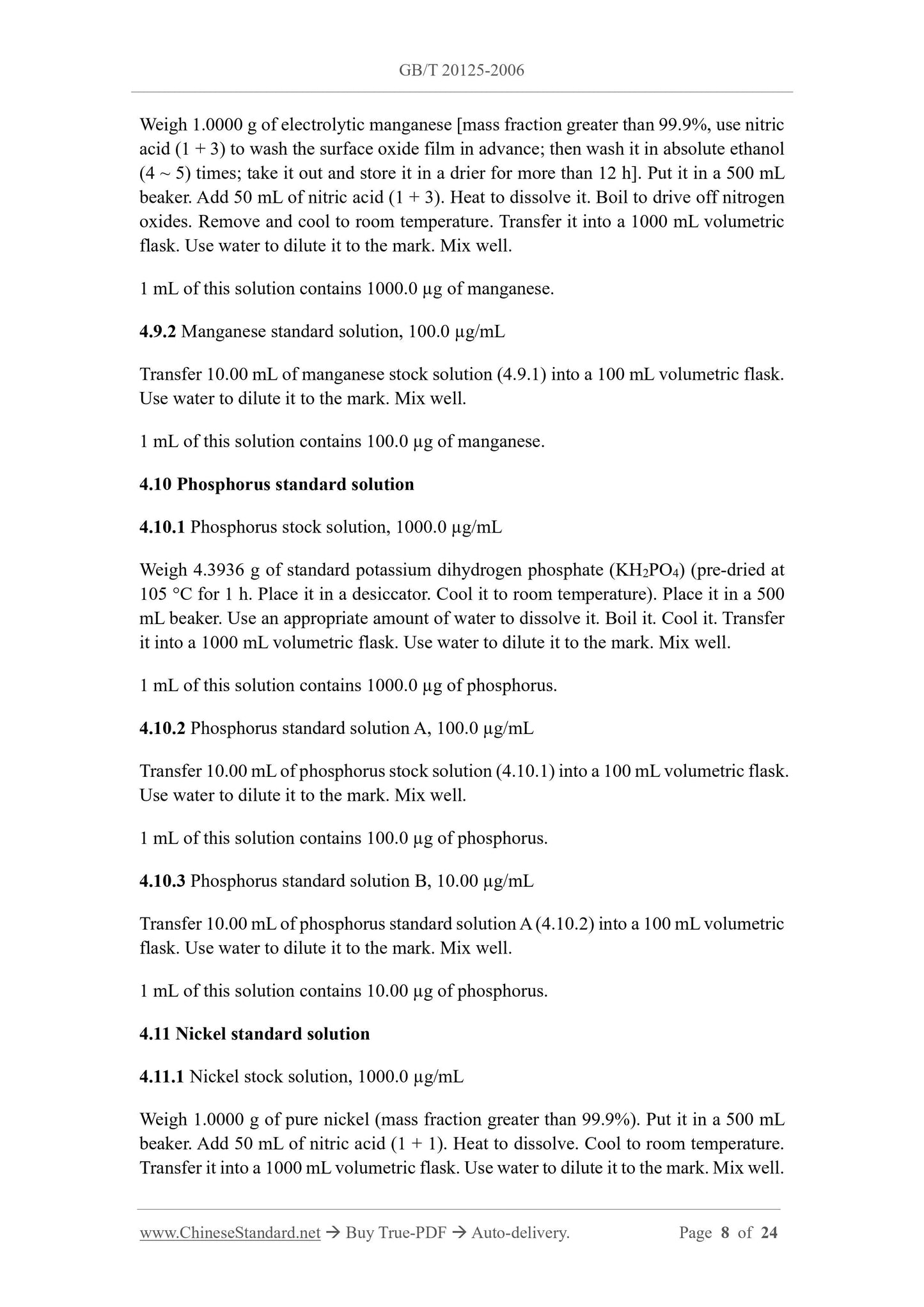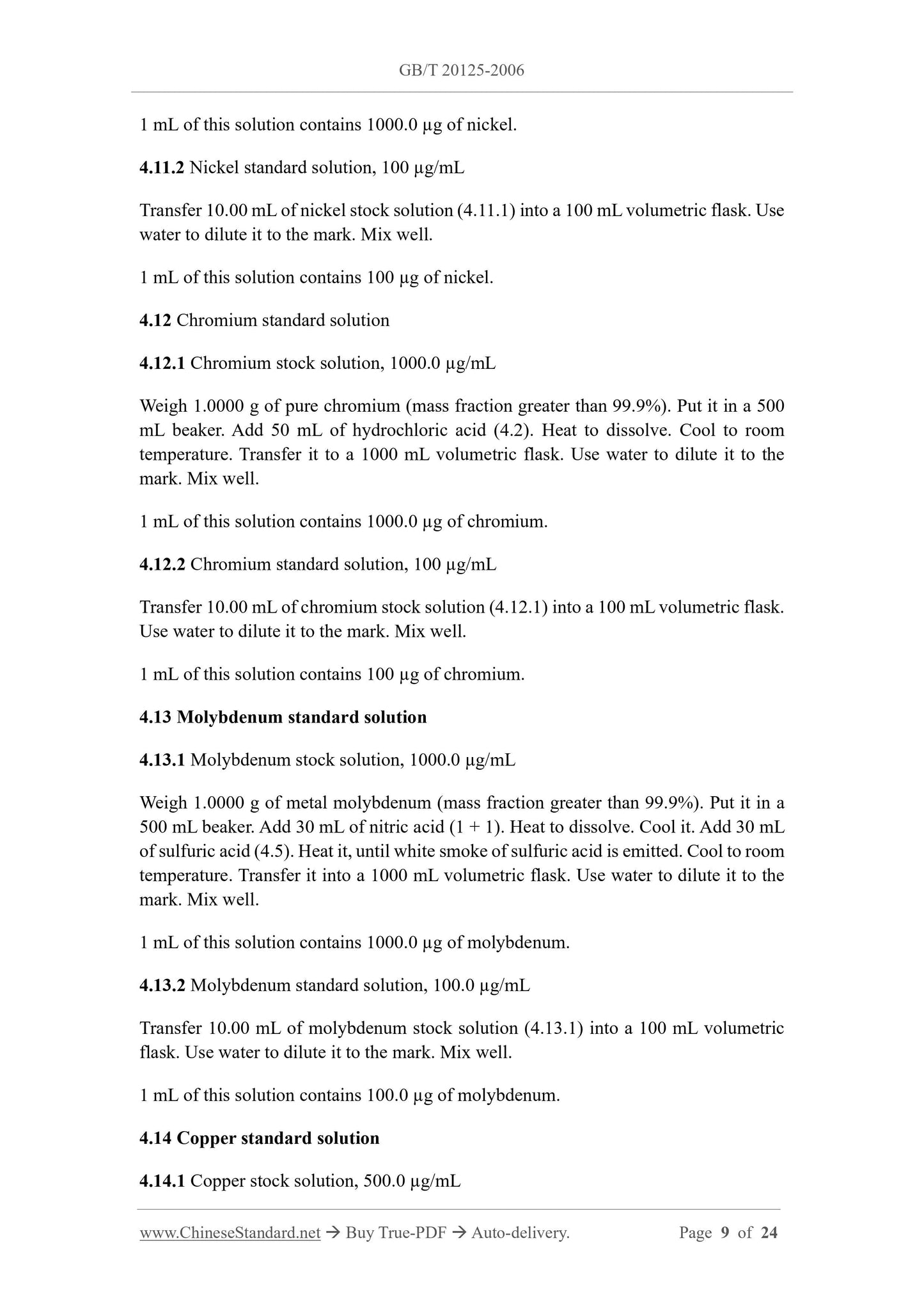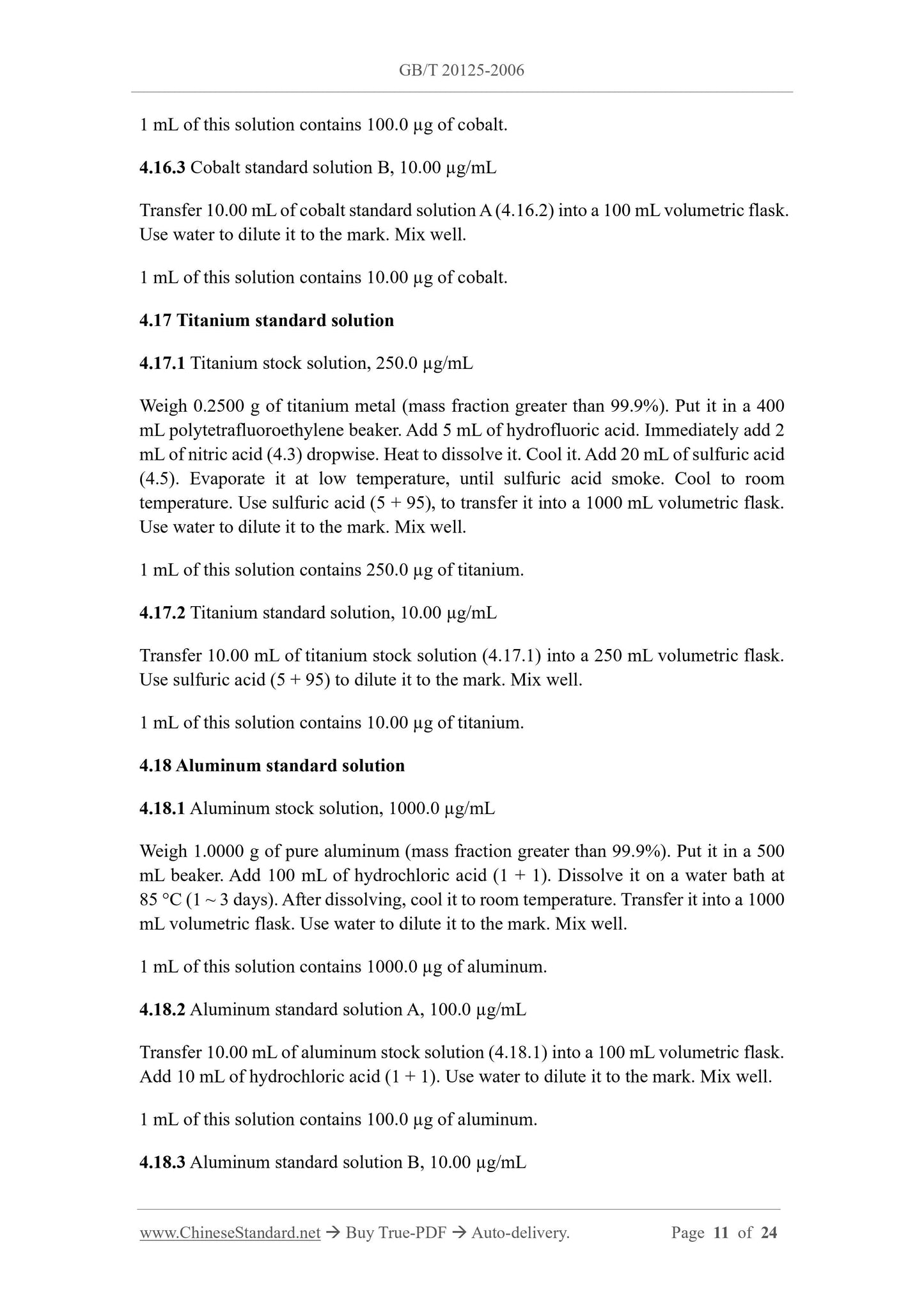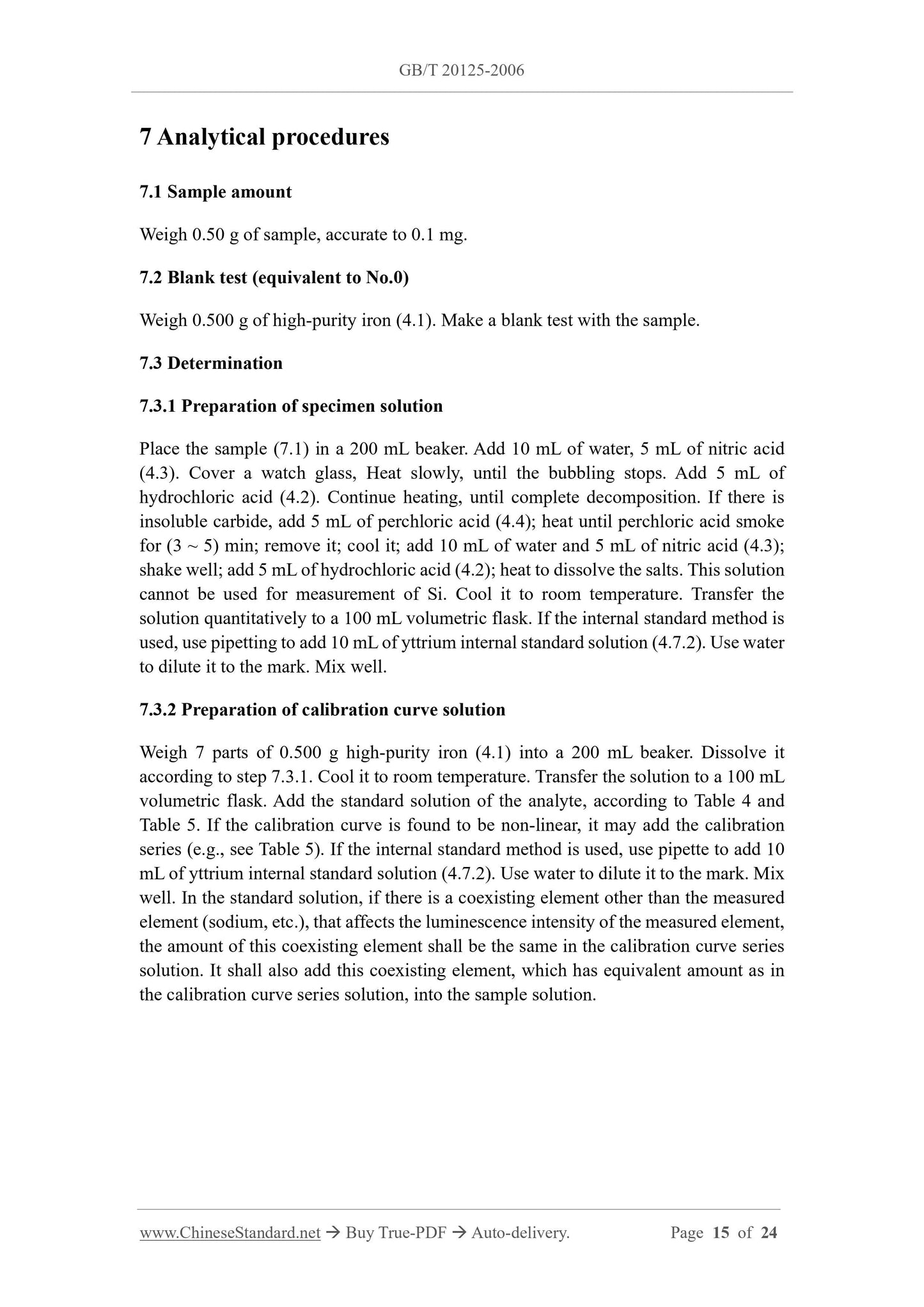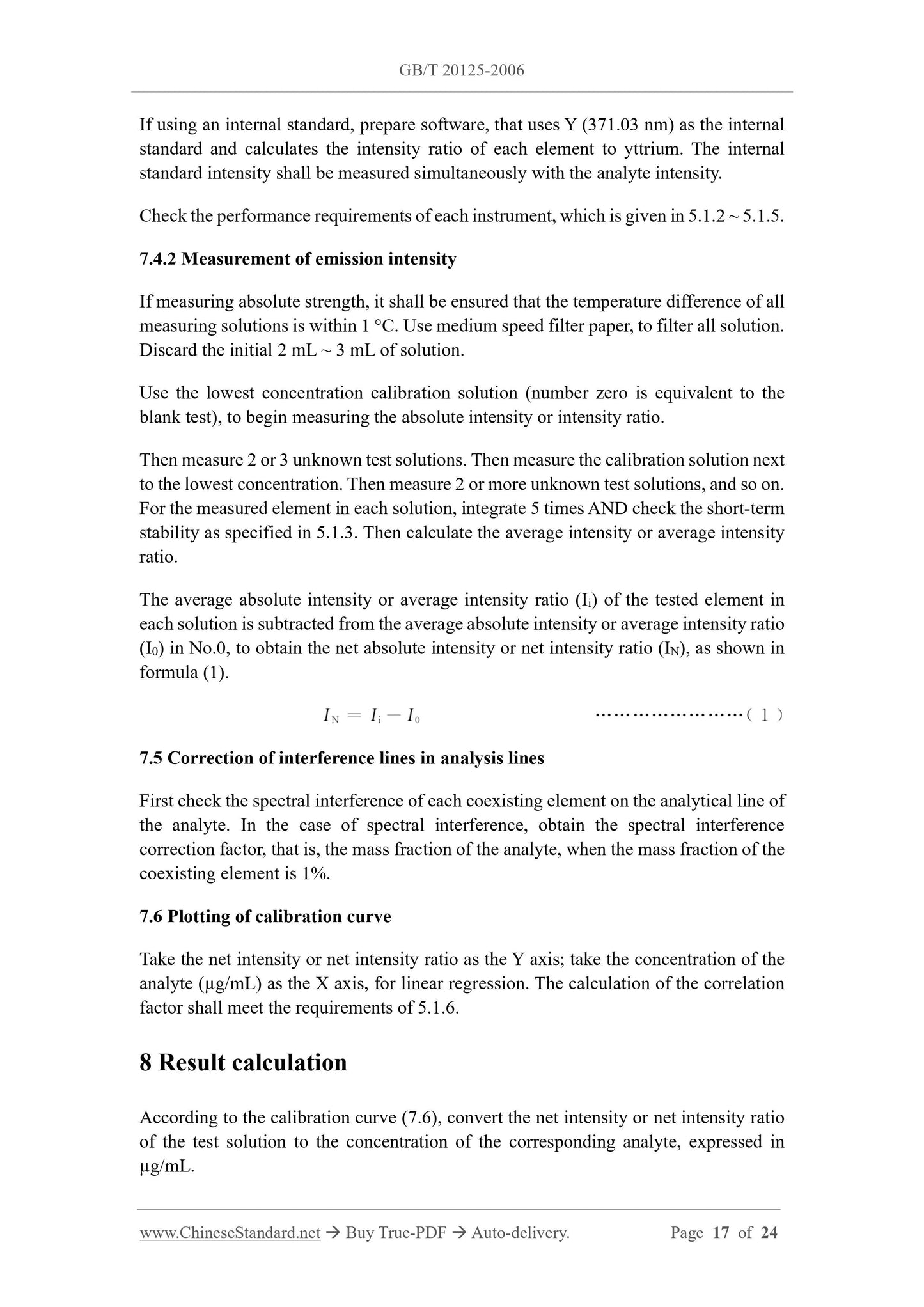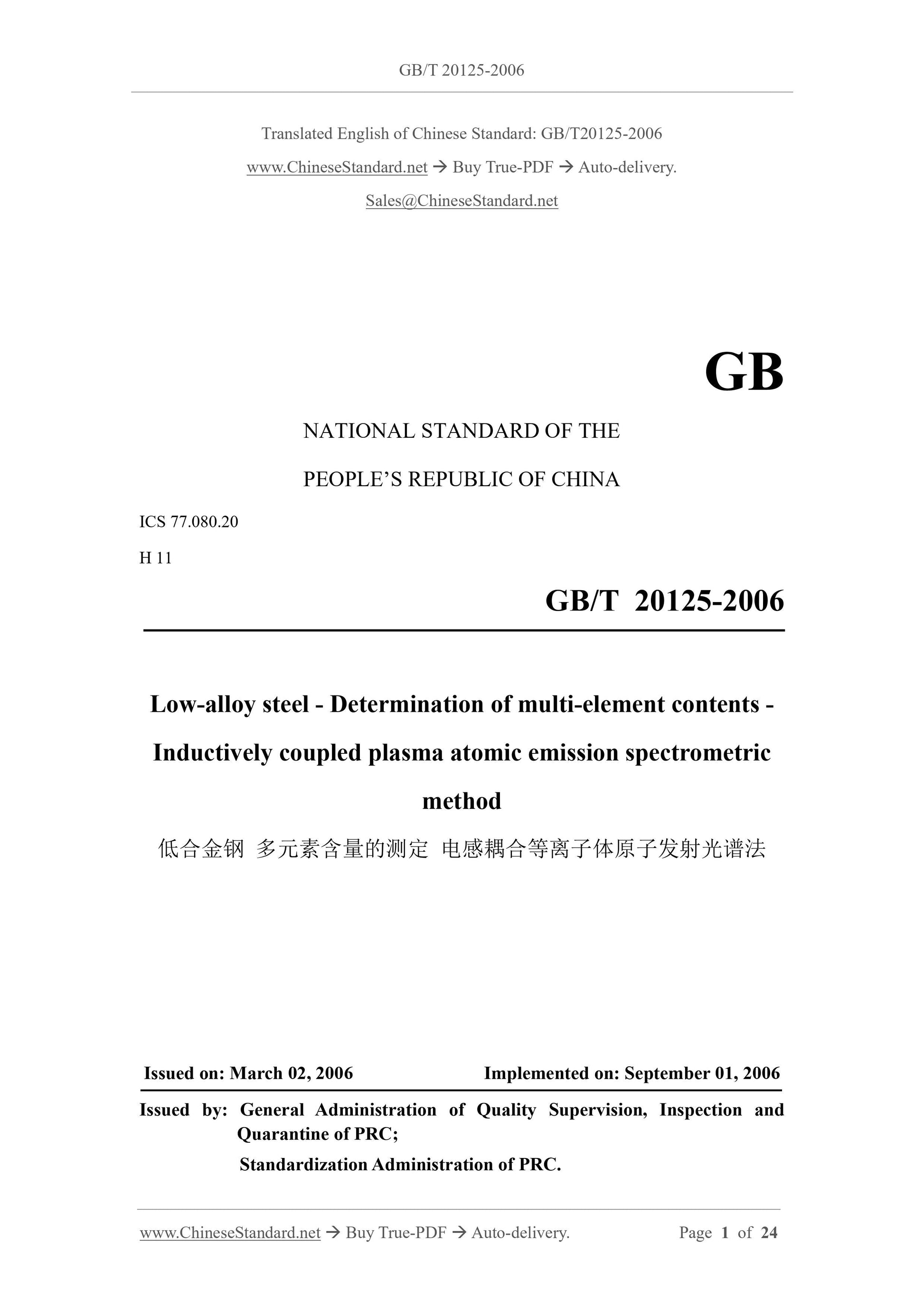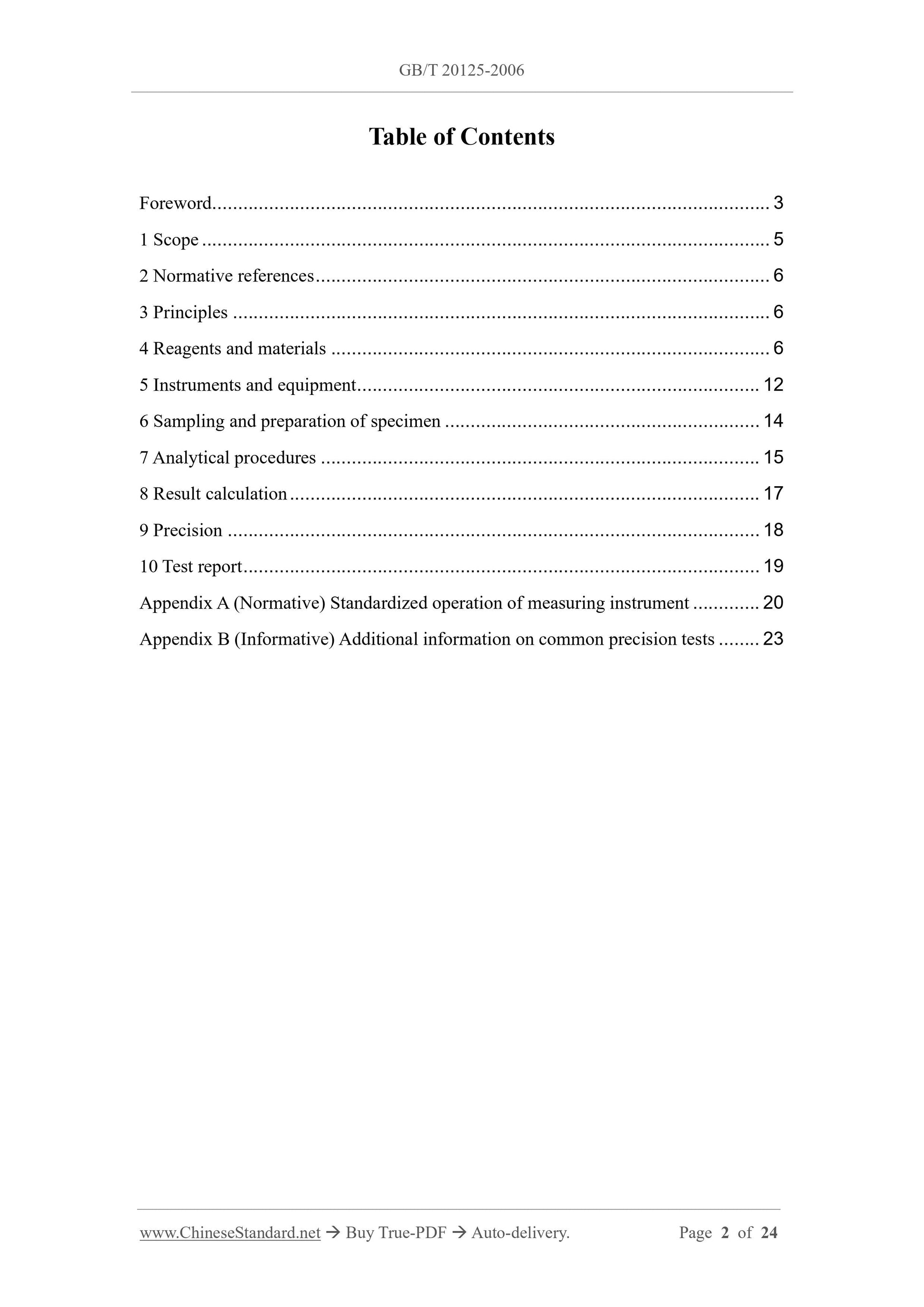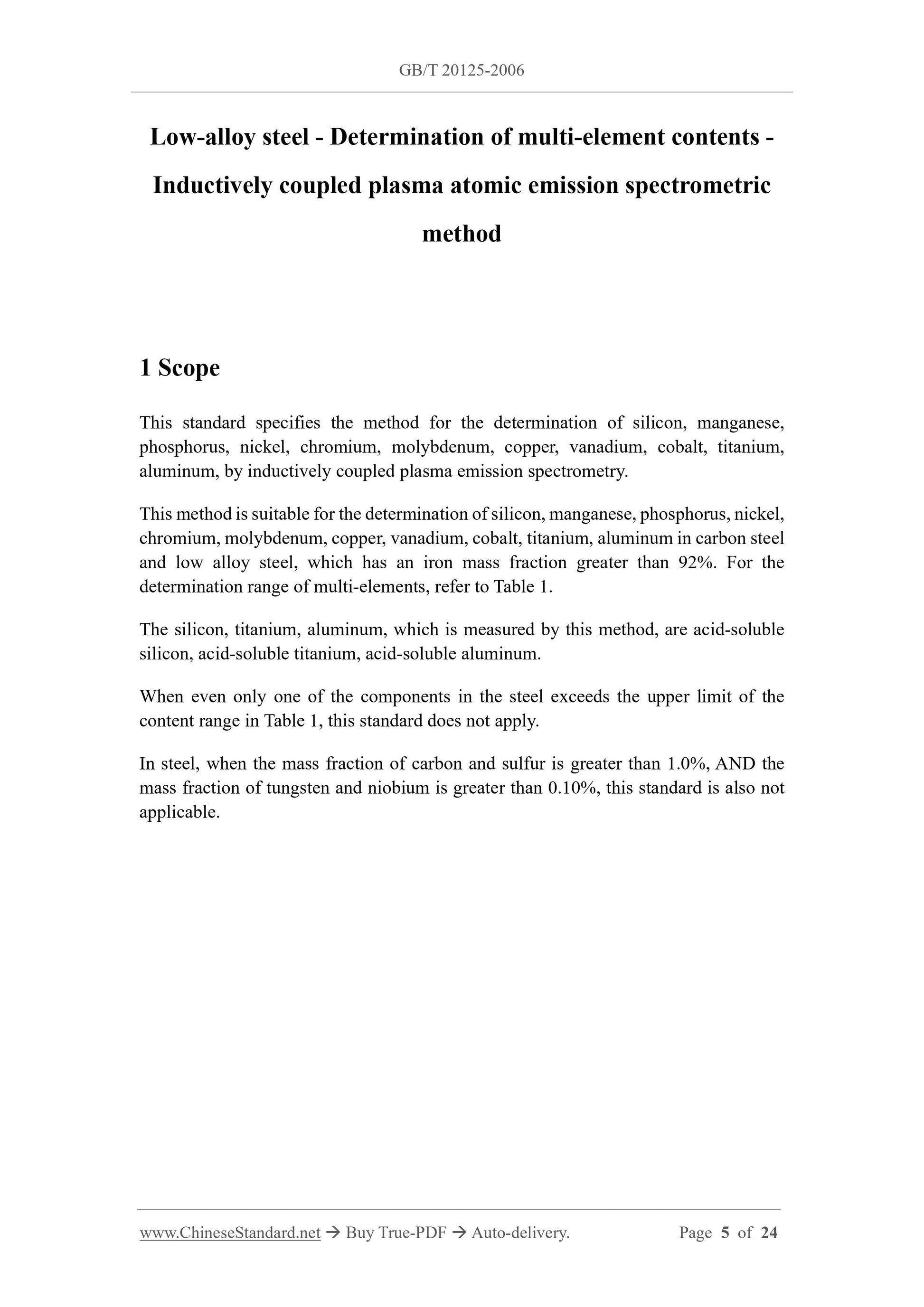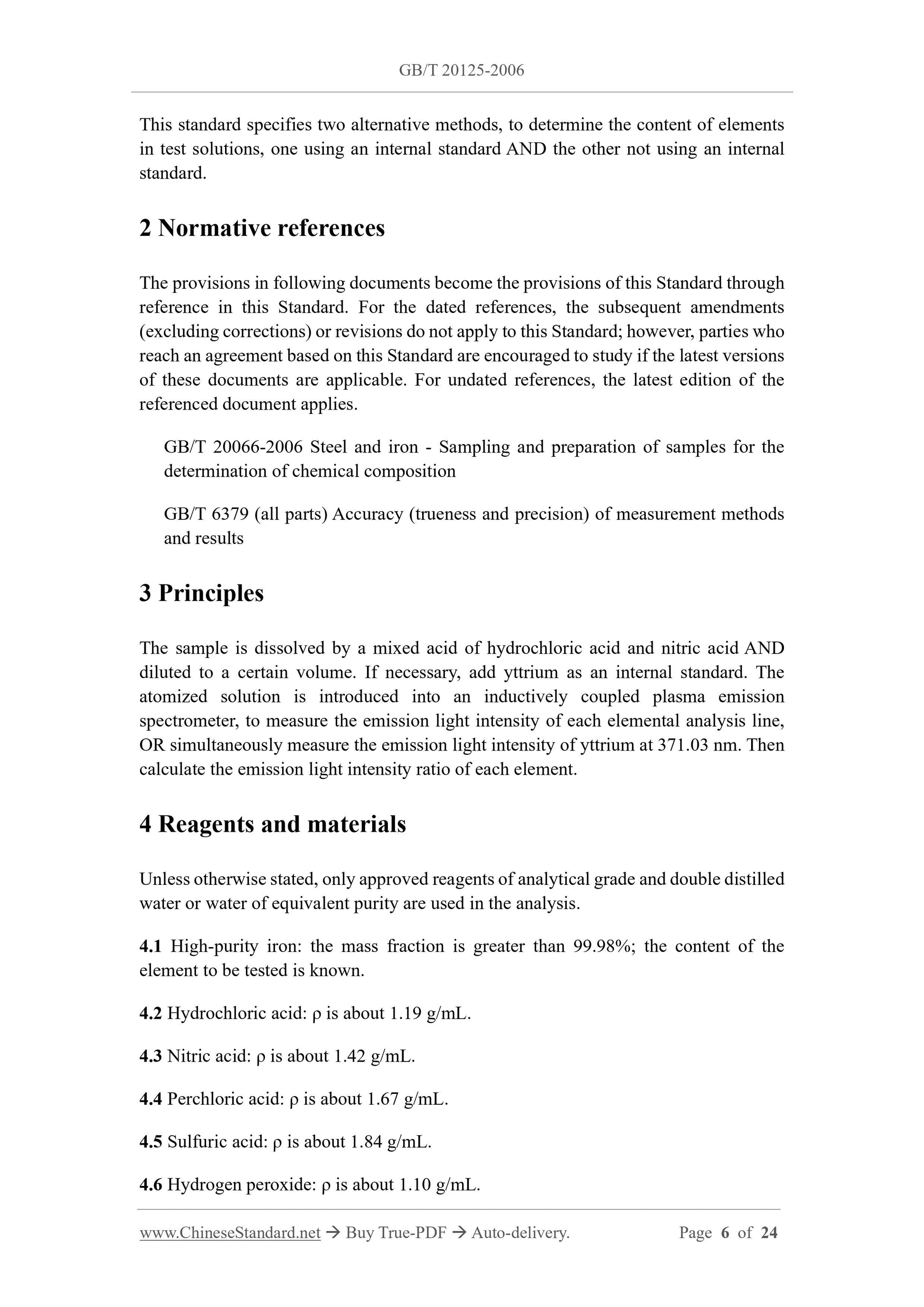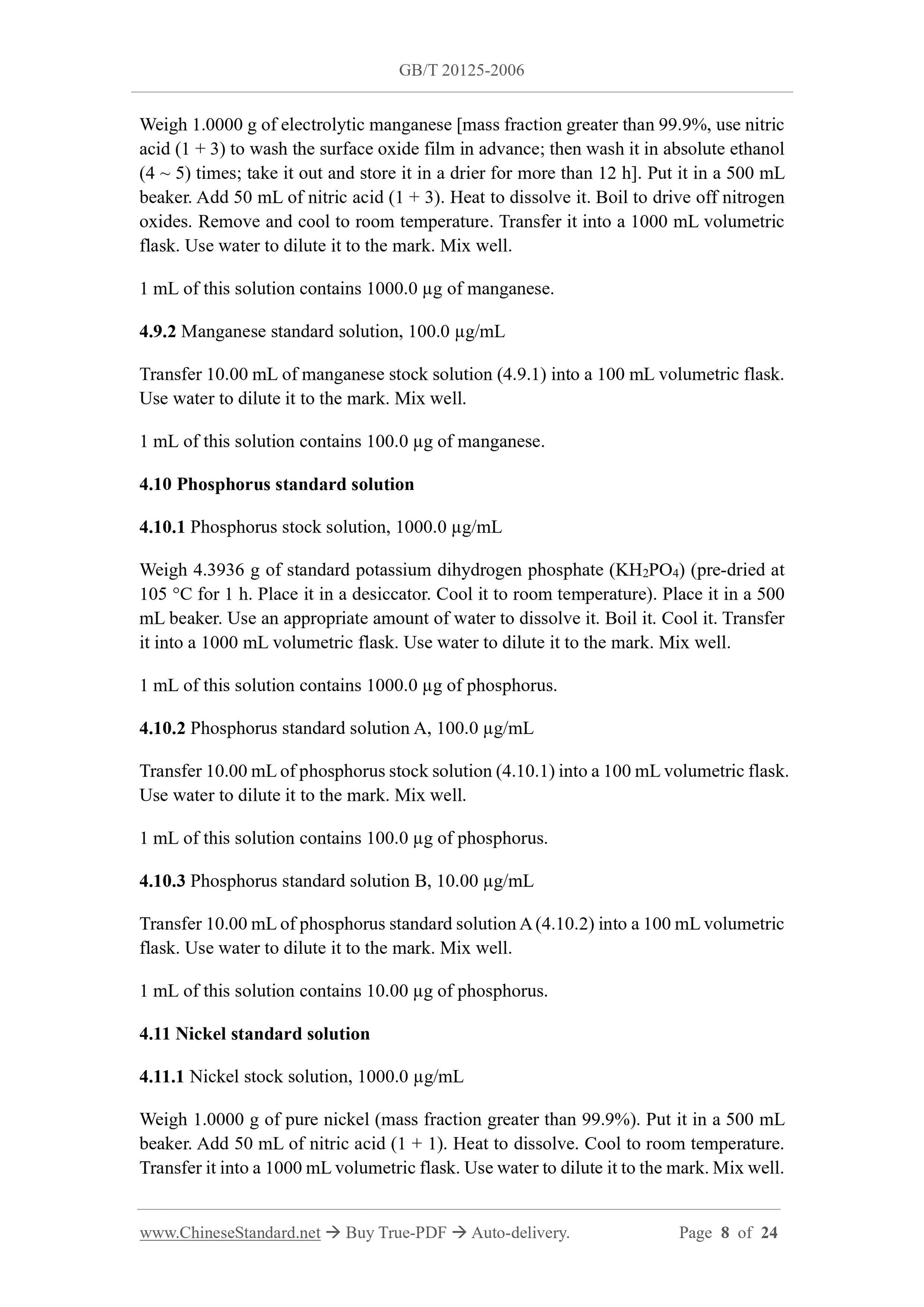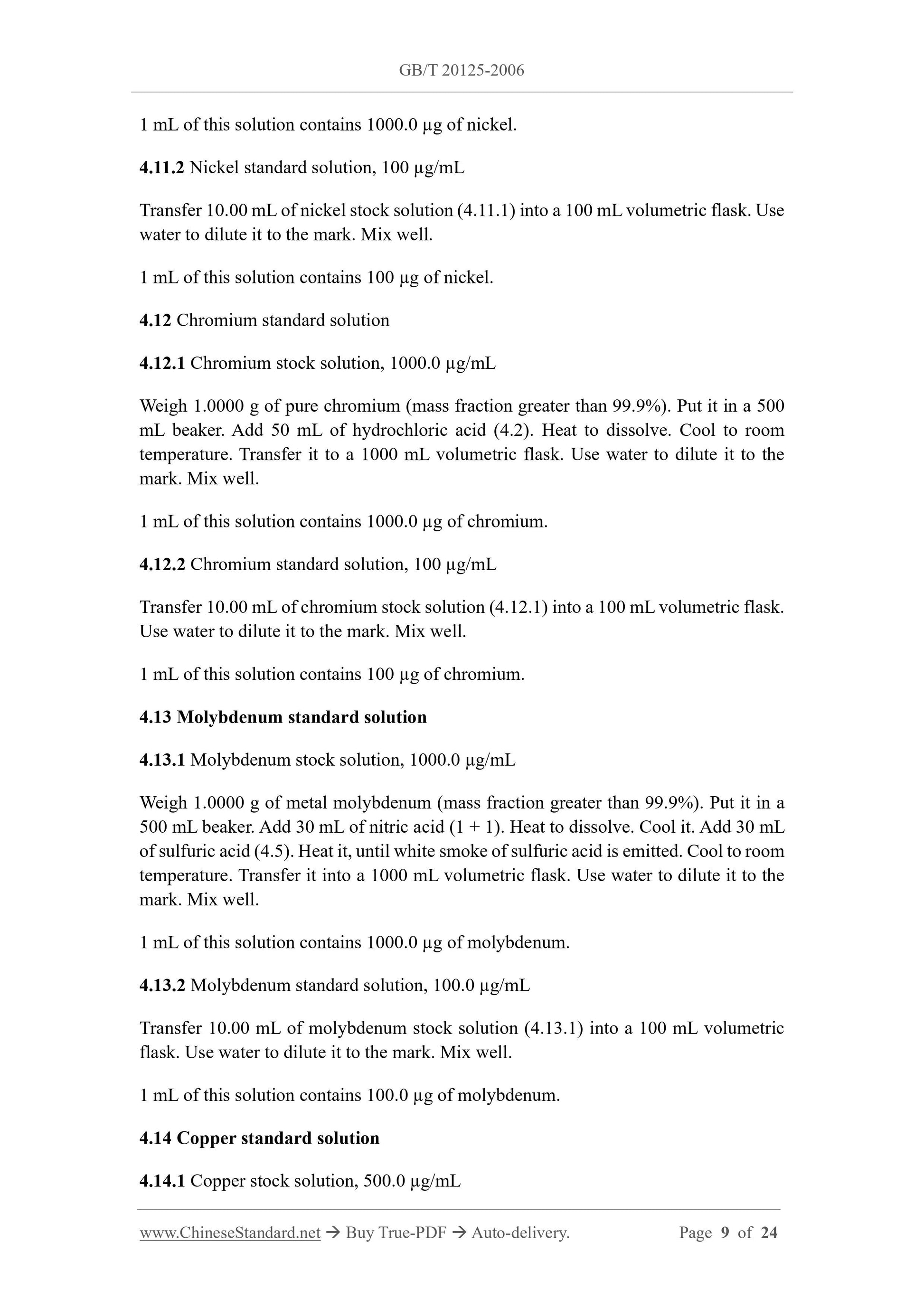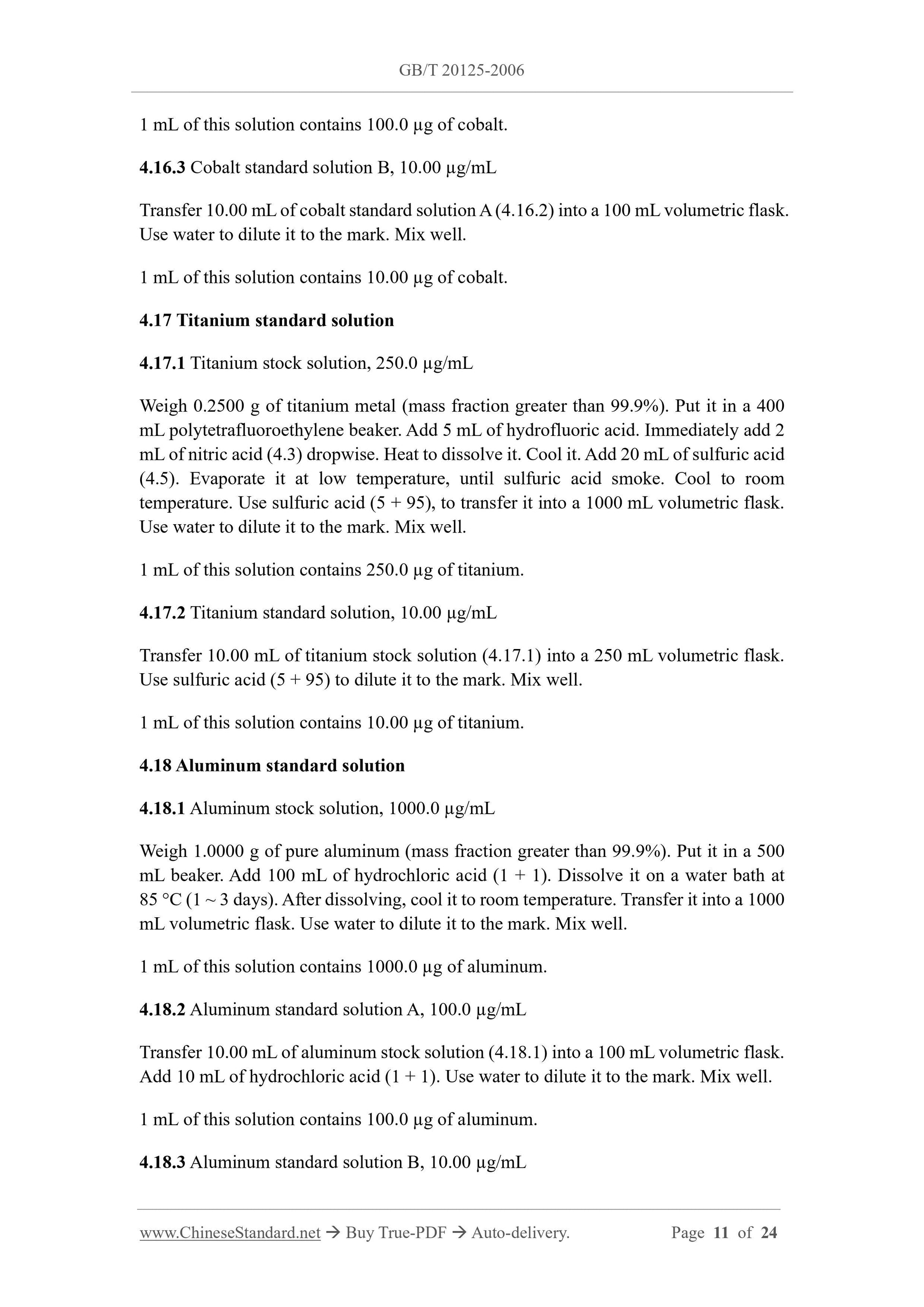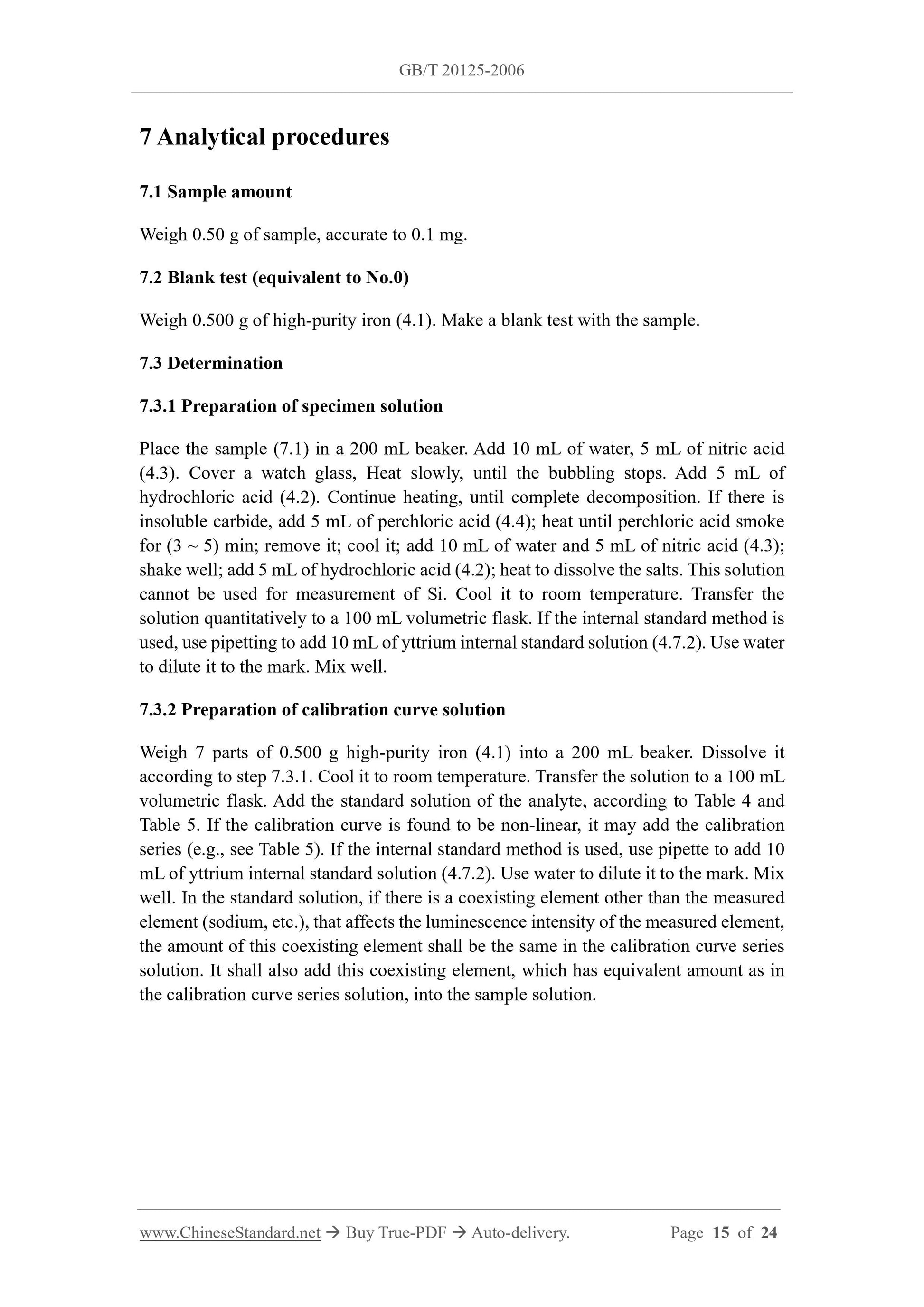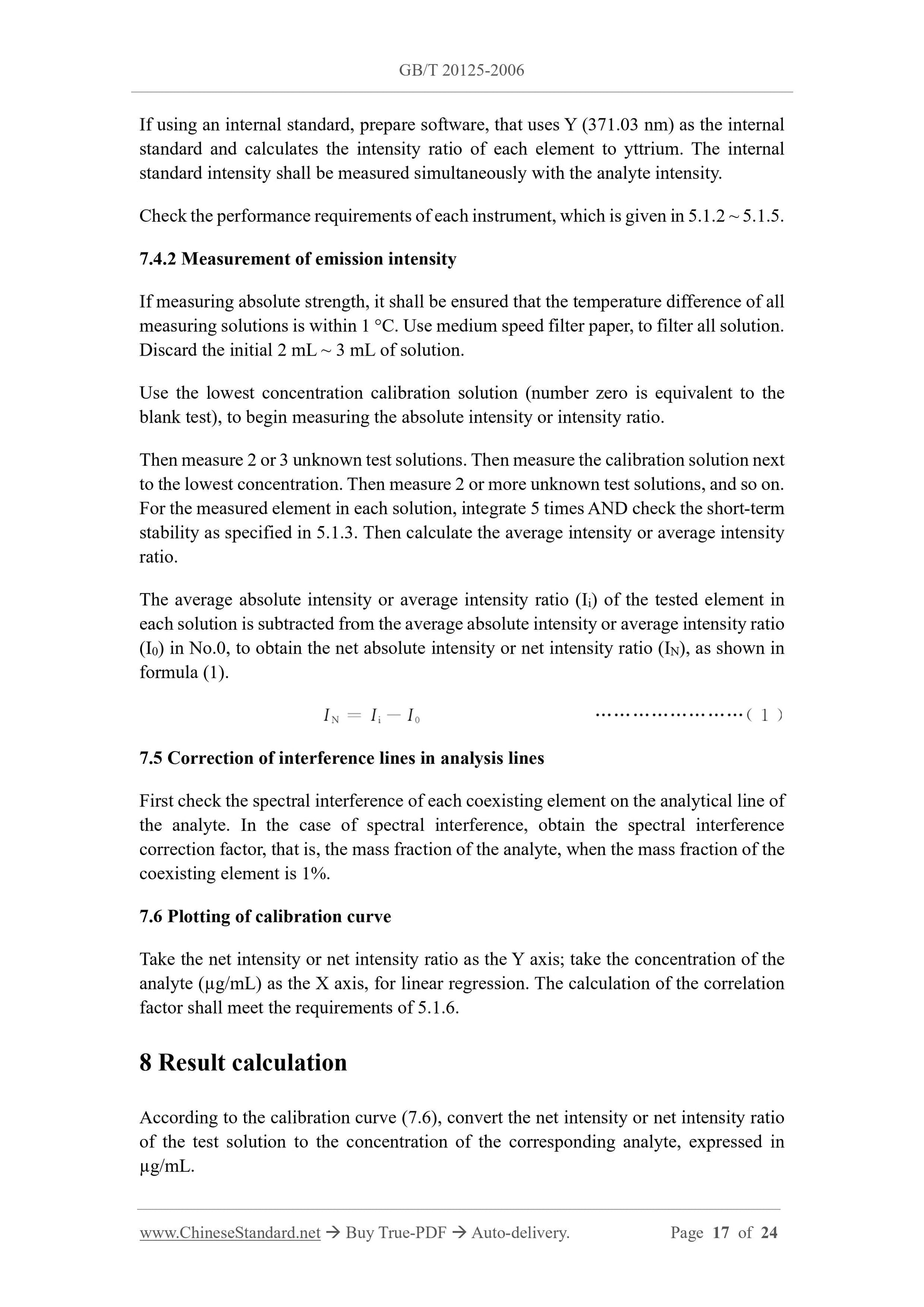1
/
of
9
PayPal, credit cards. Download editable-PDF and invoice in 1 second!
GB/T 20125-2006 English PDF (GBT20125-2006)
GB/T 20125-2006 English PDF (GBT20125-2006)
Regular price
$155.00 USD
Regular price
Sale price
$155.00 USD
Unit price
/
per
Shipping calculated at checkout.
Couldn't load pickup availability
Delivery: 3 seconds. Download true-PDF + Invoice.
Get QUOTATION in 1-minute: Click GB/T 20125-2006
Historical versions: GB/T 20125-2006
Preview True-PDF (Reload/Scroll if blank)
GB/T 20125-2006: Low-alloy steel -- Determination of multi-element contents -- Inductively coupled plasma atomic emission spectrometric method
GB/T 20125-2006
NATIONAL STANDARD OF THE
PEOPLE’S REPUBLIC OF CHINA
ICS 77.080.20
H 11
Low-alloy steel - Determination of multi-element contents -
Inductively coupled plasma atomic emission spectrometric
method
ISSUED ON: MARCH 02, 2006
IMPLEMENTED ON: SEPTEMBER 01, 2006
Issued by: General Administration of Quality Supervision, Inspection and
Quarantine of PRC;
Standardization Administration of PRC.
Table of Contents
Foreword ... 3
1 Scope ... 5
2 Normative references ... 6
3 Principles ... 6
4 Reagents and materials ... 6
5 Instruments and equipment ... 12
6 Sampling and preparation of specimen ... 14
7 Analytical procedures ... 15
8 Result calculation ... 17
9 Precision ... 18
10 Test report ... 19
Appendix A (Normative) Standardized operation of measuring instrument ... 20
Appendix B (Informative) Additional information on common precision tests ... 23
Low-alloy steel - Determination of multi-element contents -
Inductively coupled plasma atomic emission spectrometric
method
1 Scope
This standard specifies the method for the determination of silicon, manganese,
phosphorus, nickel, chromium, molybdenum, copper, vanadium, cobalt, titanium,
aluminum, by inductively coupled plasma emission spectrometry.
This method is suitable for the determination of silicon, manganese, phosphorus, nickel,
chromium, molybdenum, copper, vanadium, cobalt, titanium, aluminum in carbon steel
and low alloy steel, which has an iron mass fraction greater than 92%. For the
determination range of multi-elements, refer to Table 1.
The silicon, titanium, aluminum, which is measured by this method, are acid-soluble
silicon, acid-soluble titanium, acid-soluble aluminum.
When even only one of the components in the steel exceeds the upper limit of the
content range in Table 1, this standard does not apply.
In steel, when the mass fraction of carbon and sulfur is greater than 1.0%, AND the
mass fraction of tungsten and niobium is greater than 0.10%, this standard is also not
applicable.
This standard specifies two alternative methods, to determine the content of elements
in test solutions, one using an internal standard AND the other not using an internal
standard.
2 Normative references
The provisions in following documents become the provisions of this Standard through
reference in this Standard. For the dated references, the subsequent amendments
(excluding corrections) or revisions do not apply to this Standard; however, parties who
reach an agreement based on this Standard are encouraged to study if the latest versions
of these documents are applicable. For undated references, the latest edition of the
referenced document applies.
GB/T 20066-2006 Steel and iron - Sampling and preparation of samples for the
determination of chemical composition
GB/T 6379 (all parts) Accuracy (trueness and precision) of measurement methods
and results
3 Principles
The sample is dissolved by a mixed acid of hydrochloric acid and nitric acid AND
diluted to a certain volume. If necessary, add yttrium as an internal standard. The
atomized solution is introduced into an inductively coupled plasma emission
spectrometer, to measure the emission light intensity of each elemental analysis line,
OR simultaneously measure the emission light intensity of yttrium at 371.03 nm. Then
calculate the emission light intensity ratio of each element.
4 Reagents and materials
Unless otherwise stated, only approved reagents of analytical grade and double distilled
water or water of equivalent purity are used in the analysis.
4.1 High-purity iron: the mass fraction is greater than 99.98%; the content of the
element to be tested is known.
4.2 Hydrochloric acid: ρ is about 1.19 g/mL.
4.3 Nitric acid: ρ is about 1.42 g/mL.
4.4 Perchloric acid: ρ is about 1.67 g/mL.
4.5 Sulfuric acid: ρ is about 1.84 g/mL.
4.6 Hydrogen peroxide: ρ is about 1.10 g/mL.
Weigh 1.0000 g of electrolytic manganese [mass fraction greater than 99.9%, use nitric
acid (1 + 3) to wash the surface oxide film in advance; then wash it in absolute ethanol
(4 ~ 5) times; take it out and store it in a drier for more than 12 h]. Put it in a 500 mL
beaker. Add 50 mL of nitric acid (1 + 3). Heat to dissolve it. Boil to drive off nitrogen
oxides. Remove and cool to room temperature. Transfer it into a 1000 mL volumetric
flask. Use water to dilute it to the mark. Mix well.
1 mL of this solution contains 1000.0 µg of manganese.
4.9.2 Manganese standard solution, 100.0 µg/mL
Transfer 10.00 mL of manganese stock solution (4.9.1) into a 100 mL volumetric flask.
Use water to dilute it to the mark. Mix well.
1 mL of this solution contains 100.0 µg of manganese.
4.10 Phosphorus standard solution
4.10.1 Phosphorus stock solution, 1000.0 µg/mL
Weigh 4.3936 g of standard potassium dihydrogen phosphate (KH2PO4) (pre-dried at
105 °C for 1 h. Place it in a desiccator. Cool it to room temperature). Place it in a 500
mL beaker. Use an appropriate amount of water to dissolve it. Boil it. Cool it. Transfer
it into a 1000 mL volumetric flask. Use water to dilute it to the mark. Mix well.
1 mL of this solution contains 1000.0 µg of phosphorus.
4.10.2 Phosphorus standard solution A, 100.0 µg/mL
Transfer 10.00 mL of phosphorus stock solution (4.10.1) into a 100 mL volumetric flask.
Use water to dilute it to the mark. Mix well.
1 mL of this solution contains 100.0 µg of phosphorus.
4.10.3 Phosphorus standard solution B, 10.00 µg/mL
Transfer 10.00 mL of phosphorus standard solution A (4.10.2) into a 100 mL volumetric
flask. Use water to dilute it to the mark. Mix well.
1 mL of this solution contains 10.00 µg of phosphorus.
4.11 Nickel standard solution
4.11.1 Nickel stock solution, 1000.0 µg/mL
Weigh 1.0000 g of pure nickel (mass fraction greater than 99.9%). Put it in a 500 mL
beaker. Add 50 mL of nitric acid (1 + 1). Heat to dissolve. Cool to room temperature.
Transfer it into a 1000 mL volumetric flask. Use water to dilute it to the mark. Mix well.
1 mL of this solution contains 1000.0 µg of nickel.
4.11.2 Nickel standard solution, 100 µg/mL
Transfer 10.00 mL of nickel stock solution (4.11.1) into a 100 mL volumetric flask. Use
water to dilute it to the mark. Mix well.
1 mL of this solution contains 100 µg of nickel.
4.12 Chromium standard solution
4.12.1 Chromium stock solution, 1000.0 µg/mL
Weigh 1.0000 g of pure chromium (mass fraction greater than 99.9%). Put it in a 500
mL beaker. Add 50 mL of hydrochloric acid (4.2). Heat to dissolve. Cool to room
temperature. Transfer it to a 1000 mL volumetric flask. Use water to dilute it to the
mark. Mix well.
1 mL of this solution contains 1000.0 µg of chromium.
4.12.2 Chromium standard solution, 100 µg/mL
Transfer 10.00 mL of chromium stock solution (4.12.1) into a 100 mL volumetric flask.
Use water to dilute it to the mark. Mix well.
1 mL of this solution contains 100 µg of chromium.
4.13 Molybdenum standard solution
4.13.1 Molybdenum stock solution, 1000.0 µg/mL
Weigh 1.0000 g of metal molybdenum (mass fraction greater than 99.9%). Put it in a
500 mL beaker. Add 30 mL of nitric acid (1 + 1). Heat to dissolve. Cool it. Add 30 mL
of sulfuric acid (4.5). Heat it, until white smoke of sulfuric acid is emitted. Cool to room
temperature. Transfer it into a 1000 mL volumetric flask. Use water to dilute it to the
mark. Mix well.
1 mL of this solution contains 1000.0 µg of molybdenum.
4.1...
Get QUOTATION in 1-minute: Click GB/T 20125-2006
Historical versions: GB/T 20125-2006
Preview True-PDF (Reload/Scroll if blank)
GB/T 20125-2006: Low-alloy steel -- Determination of multi-element contents -- Inductively coupled plasma atomic emission spectrometric method
GB/T 20125-2006
NATIONAL STANDARD OF THE
PEOPLE’S REPUBLIC OF CHINA
ICS 77.080.20
H 11
Low-alloy steel - Determination of multi-element contents -
Inductively coupled plasma atomic emission spectrometric
method
ISSUED ON: MARCH 02, 2006
IMPLEMENTED ON: SEPTEMBER 01, 2006
Issued by: General Administration of Quality Supervision, Inspection and
Quarantine of PRC;
Standardization Administration of PRC.
Table of Contents
Foreword ... 3
1 Scope ... 5
2 Normative references ... 6
3 Principles ... 6
4 Reagents and materials ... 6
5 Instruments and equipment ... 12
6 Sampling and preparation of specimen ... 14
7 Analytical procedures ... 15
8 Result calculation ... 17
9 Precision ... 18
10 Test report ... 19
Appendix A (Normative) Standardized operation of measuring instrument ... 20
Appendix B (Informative) Additional information on common precision tests ... 23
Low-alloy steel - Determination of multi-element contents -
Inductively coupled plasma atomic emission spectrometric
method
1 Scope
This standard specifies the method for the determination of silicon, manganese,
phosphorus, nickel, chromium, molybdenum, copper, vanadium, cobalt, titanium,
aluminum, by inductively coupled plasma emission spectrometry.
This method is suitable for the determination of silicon, manganese, phosphorus, nickel,
chromium, molybdenum, copper, vanadium, cobalt, titanium, aluminum in carbon steel
and low alloy steel, which has an iron mass fraction greater than 92%. For the
determination range of multi-elements, refer to Table 1.
The silicon, titanium, aluminum, which is measured by this method, are acid-soluble
silicon, acid-soluble titanium, acid-soluble aluminum.
When even only one of the components in the steel exceeds the upper limit of the
content range in Table 1, this standard does not apply.
In steel, when the mass fraction of carbon and sulfur is greater than 1.0%, AND the
mass fraction of tungsten and niobium is greater than 0.10%, this standard is also not
applicable.
This standard specifies two alternative methods, to determine the content of elements
in test solutions, one using an internal standard AND the other not using an internal
standard.
2 Normative references
The provisions in following documents become the provisions of this Standard through
reference in this Standard. For the dated references, the subsequent amendments
(excluding corrections) or revisions do not apply to this Standard; however, parties who
reach an agreement based on this Standard are encouraged to study if the latest versions
of these documents are applicable. For undated references, the latest edition of the
referenced document applies.
GB/T 20066-2006 Steel and iron - Sampling and preparation of samples for the
determination of chemical composition
GB/T 6379 (all parts) Accuracy (trueness and precision) of measurement methods
and results
3 Principles
The sample is dissolved by a mixed acid of hydrochloric acid and nitric acid AND
diluted to a certain volume. If necessary, add yttrium as an internal standard. The
atomized solution is introduced into an inductively coupled plasma emission
spectrometer, to measure the emission light intensity of each elemental analysis line,
OR simultaneously measure the emission light intensity of yttrium at 371.03 nm. Then
calculate the emission light intensity ratio of each element.
4 Reagents and materials
Unless otherwise stated, only approved reagents of analytical grade and double distilled
water or water of equivalent purity are used in the analysis.
4.1 High-purity iron: the mass fraction is greater than 99.98%; the content of the
element to be tested is known.
4.2 Hydrochloric acid: ρ is about 1.19 g/mL.
4.3 Nitric acid: ρ is about 1.42 g/mL.
4.4 Perchloric acid: ρ is about 1.67 g/mL.
4.5 Sulfuric acid: ρ is about 1.84 g/mL.
4.6 Hydrogen peroxide: ρ is about 1.10 g/mL.
Weigh 1.0000 g of electrolytic manganese [mass fraction greater than 99.9%, use nitric
acid (1 + 3) to wash the surface oxide film in advance; then wash it in absolute ethanol
(4 ~ 5) times; take it out and store it in a drier for more than 12 h]. Put it in a 500 mL
beaker. Add 50 mL of nitric acid (1 + 3). Heat to dissolve it. Boil to drive off nitrogen
oxides. Remove and cool to room temperature. Transfer it into a 1000 mL volumetric
flask. Use water to dilute it to the mark. Mix well.
1 mL of this solution contains 1000.0 µg of manganese.
4.9.2 Manganese standard solution, 100.0 µg/mL
Transfer 10.00 mL of manganese stock solution (4.9.1) into a 100 mL volumetric flask.
Use water to dilute it to the mark. Mix well.
1 mL of this solution contains 100.0 µg of manganese.
4.10 Phosphorus standard solution
4.10.1 Phosphorus stock solution, 1000.0 µg/mL
Weigh 4.3936 g of standard potassium dihydrogen phosphate (KH2PO4) (pre-dried at
105 °C for 1 h. Place it in a desiccator. Cool it to room temperature). Place it in a 500
mL beaker. Use an appropriate amount of water to dissolve it. Boil it. Cool it. Transfer
it into a 1000 mL volumetric flask. Use water to dilute it to the mark. Mix well.
1 mL of this solution contains 1000.0 µg of phosphorus.
4.10.2 Phosphorus standard solution A, 100.0 µg/mL
Transfer 10.00 mL of phosphorus stock solution (4.10.1) into a 100 mL volumetric flask.
Use water to dilute it to the mark. Mix well.
1 mL of this solution contains 100.0 µg of phosphorus.
4.10.3 Phosphorus standard solution B, 10.00 µg/mL
Transfer 10.00 mL of phosphorus standard solution A (4.10.2) into a 100 mL volumetric
flask. Use water to dilute it to the mark. Mix well.
1 mL of this solution contains 10.00 µg of phosphorus.
4.11 Nickel standard solution
4.11.1 Nickel stock solution, 1000.0 µg/mL
Weigh 1.0000 g of pure nickel (mass fraction greater than 99.9%). Put it in a 500 mL
beaker. Add 50 mL of nitric acid (1 + 1). Heat to dissolve. Cool to room temperature.
Transfer it into a 1000 mL volumetric flask. Use water to dilute it to the mark. Mix well.
1 mL of this solution contains 1000.0 µg of nickel.
4.11.2 Nickel standard solution, 100 µg/mL
Transfer 10.00 mL of nickel stock solution (4.11.1) into a 100 mL volumetric flask. Use
water to dilute it to the mark. Mix well.
1 mL of this solution contains 100 µg of nickel.
4.12 Chromium standard solution
4.12.1 Chromium stock solution, 1000.0 µg/mL
Weigh 1.0000 g of pure chromium (mass fraction greater than 99.9%). Put it in a 500
mL beaker. Add 50 mL of hydrochloric acid (4.2). Heat to dissolve. Cool to room
temperature. Transfer it to a 1000 mL volumetric flask. Use water to dilute it to the
mark. Mix well.
1 mL of this solution contains 1000.0 µg of chromium.
4.12.2 Chromium standard solution, 100 µg/mL
Transfer 10.00 mL of chromium stock solution (4.12.1) into a 100 mL volumetric flask.
Use water to dilute it to the mark. Mix well.
1 mL of this solution contains 100 µg of chromium.
4.13 Molybdenum standard solution
4.13.1 Molybdenum stock solution, 1000.0 µg/mL
Weigh 1.0000 g of metal molybdenum (mass fraction greater than 99.9%). Put it in a
500 mL beaker. Add 30 mL of nitric acid (1 + 1). Heat to dissolve. Cool it. Add 30 mL
of sulfuric acid (4.5). Heat it, until white smoke of sulfuric acid is emitted. Cool to room
temperature. Transfer it into a 1000 mL volumetric flask. Use water to dilute it to the
mark. Mix well.
1 mL of this solution contains 1000.0 µg of molybdenum.
4.1...
Share
